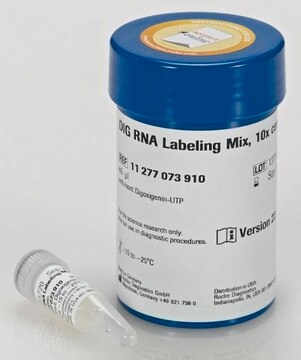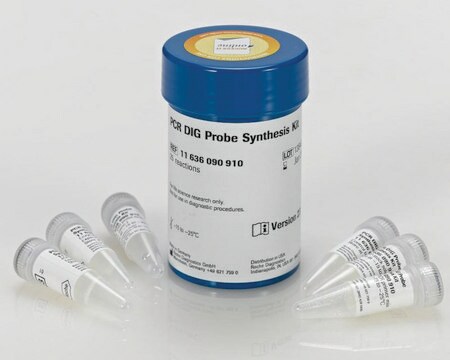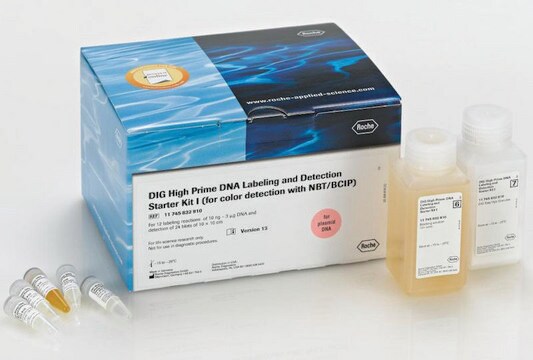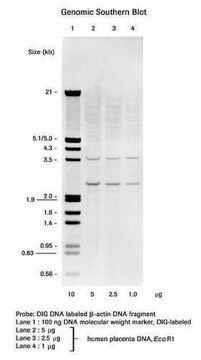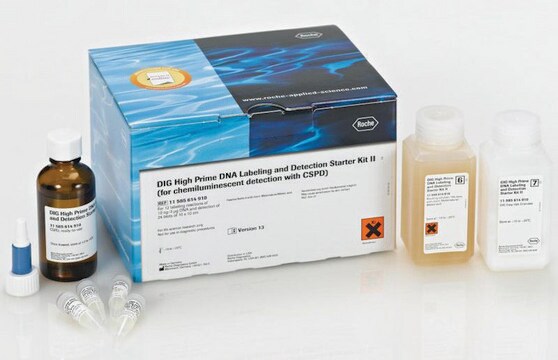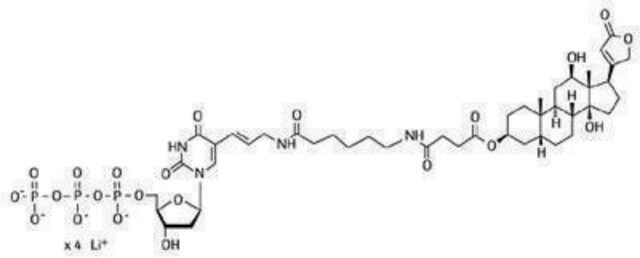Kluczowe dokumenty
11277065910
Roche
DIG DNA Labeling Mix
Synonim(y):
DNA labeling
About This Item
Polecane produkty
Postać
solution
Poziom jakości
zastosowanie
sufficient for 25 standard reactions
opakowanie
pkg of 50 μL
producent / nazwa handlowa
Roche
charakterystyka ekologicznej alternatywy
Designing Safer Chemicals
Learn more about the Principles of Green Chemistry.
sustainability
Greener Alternative Product
kolor
colorless
rozpuszczalność
water: miscible
kategoria ekologicznej alternatywy
temp. przechowywania
−20°C
Opis ogólny
We are committed to bringing you Greener Alternative Products, which adhere to one or more of The 12 Principles of Greener Chemistry. This product is designed as a safer chemical. The DIG System was established as a sensitive and cost-effective alternative to radioactivity for the labeling and detection of nucleic acids. There are many available publications that prove the versatility of the DIG System, so use of radio-labeling is no longer the only option for labeling of DNA for hybridization.
Zastosowanie
- Southern blots
- northern blots
- dot blots
- screening of gene libraries
- in situ hybridizations
Cechy i korzyści
10x concentrated dNTP labeling mixture: 1mM dATP, 1mM dCTP, 1mM dGTP, 0.65mM dTTP, 0.35mM DIG-dUTP, alkali-labile, pH 7.5 (+20°C)
Assay Time: Labeling: 1 hour to O/N
Labeling efficiency: With 1μg DNA per assay, approx. 10% of the nucleotides are incorporated into about 250ng of newly synthesized labeled DNA within 1 hour and approx. 30% of the nucleotides into about 750ng after 20 hours.
Jakość
Zasada
Uwaga dotycząca przygotowania
As template for the labeling reaction
- DNA fragments of at least 100bp
- Linearized plasmids, cosmid or λDNA,
- Supercoiled DNA,
- Or minimal amounts of DNA (10ng), e.g., DNA restriction fragments isolated from low melting point agarose can be used.
Note: Linear DNA is labeled more efficiently than circular and supercoiled DNA.
Inne uwagi
Kod klasy składowania
12 - Non Combustible Liquids
Klasa zagrożenia wodnego (WGK)
nwg
Temperatura zapłonu (°F)
No data available
Temperatura zapłonu (°C)
No data available
Certyfikaty analizy (CoA)
Poszukaj Certyfikaty analizy (CoA), wpisując numer partii/serii produktów. Numery serii i partii można znaleźć na etykiecie produktu po słowach „seria” lub „partia”.
Masz już ten produkt?
Dokumenty związane z niedawno zakupionymi produktami zostały zamieszczone w Bibliotece dokumentów.
Klienci oglądali również te produkty
Produkty
Digoxigenin (DIG) labeling methods and kits for DNA and RNA DIG probes, random primed DNA labeling, nick translation labeling, 5’ and 3’ oligonucleotide end-labeling.
Metody znakowania digoksygeniną (DIG) i zestawy do sond DNA i RNA DIG, znakowanie DNA z losowym primerem, znakowanie nickiem translacyjnym, znakowanie końcowe oligonukleotydów 5' i 3'.
Nasz zespół naukowców ma doświadczenie we wszystkich obszarach badań, w tym w naukach przyrodniczych, materiałoznawstwie, syntezie chemicznej, chromatografii, analityce i wielu innych dziedzinach.
Skontaktuj się z zespołem ds. pomocy technicznej

